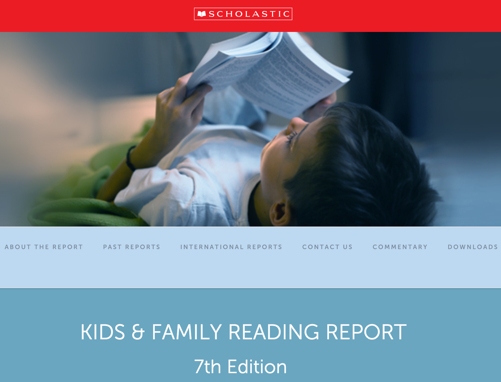Scholastic Releases Kids & Family Reading Report: 7th Edition
From Scholastic:
Scholastic today released results from the seventh edition of its Kids & Family Reading Report™, a biennial national survey of parents’ and children’s reading attitudes and behaviors. Those surveyed include more than 1,000 pairs of children ages 6–17 and their parents, as well as 678 parents of kids ages 0–5.
The research reveals the diversity parents and children seek in books, explores how reading helps children understand their world and indicates the importance of book access and reading role models.
[Clip]
Finding Their Story: A Precarious “Decline by Nine”
The study found the percentage of kids defined as frequent readers (reading books for fun 5–7 days a week) drops from 57% among 8-year-olds to 35% among 9-year-olds. The data also shows a drop between ages eight and nine in the number of kids who say they love reading (from 40% to 28%), as well as the percentage of kids who think reading books for fun is important (from 65% to 57%). The Kids & Family Reading Report has shown a child’s attitude towards reading enjoyment and importance is a predictor of reading frequency, which makes the trends in this year’s report so striking.
Reading helps kids navigate the world. The vast majority of parents (88%) believe that reading fiction and nonfiction is a good way for their child to better understand the world. Three in four children agree. More than half of kids (53%) and parents (55%) also agree a book has helped them or their child through a difficult time. Nevertheless, the data cited above shows that a young reader’s journey is at risk.
Families expect more from children’s books.In the past two years, both kids and parents are less likely to say that when picking a children’s book to read for fun, the type of book doesn’t matter, it just has to be a good story (down 17 points among kids; 21 points among parents).
- More kids want books that make them laugh (up 10 points to 52%), help them explore new worlds (up nine points to 40%) and become familiar with new topics (up seven points to 26%).
- More parents want these types of books, as well as those which help their child learn about the lives of others (up 12 points to 48%) and books that make their child think and feel (up nine points to 51%).
[Clip]
Finding Their Story: Diversity in Children’s Books in Demand
The survey underscores the importance of diversity and how broadly it is defined. A majority of parents and a near majority of kids ages 9–17 say diversity in children’s books includes people and experiences different than their own – representations of various cultures, customs, religions, settings and living situations. For others, diversity in children’s books includes differently-abled people, people of color and LGBTQ people.
- Many want diversity in books. About half of kids ages 9–17 and parents with kids ages 6–17 agree “I wish there were more books available that include diversity;” among kids and parents who agree that diversity in children’s books is important, these percentages rise to 76% of kids and 69% of parents. Black and Hispanic families overall have the strongest views on the importance of and need for books with diversity.
- Demand is on the rise. Kids ages 12–17 and parents of children of all ages are more likely today than they were in 2016 to want books that include diverse storylines, characters or settings (18% of kids, up five points; 31% of parents with kids ages 6–17, up five points; parents of children ages 5 and under up 9 points to 36%).
- Characters build character. This year’s survey asked parents to prioritize the qualities they hope their children develop. Responsibility, self-confidence, honesty, respectfulness and kindness top the list. Parents know that cultivating these qualities can be challenging, and they overwhelmingly believe reading can help: 95% agree that characters in books can help inspire the development of these qualities in their child.
[Clip]
Finding Their Story: Access matters
The report shows clear parallels between access to books and reading role models and kids’ reading frequency.
- Kids need help finding books. While four in 10 kids agree that they have trouble finding books that they like, this is far higher among infrequent readers than frequent readers (59% vs. 32%) and is true of roughly half of kids by age nine.
- Reading role models show kids the way. Frequent readers are more likely to be surrounded by people who they perceive to enjoy reading: 82% say a lot or nearly everyone they know enjoys reading, versus infrequent readers at 34%. And much like reading frequency, there’s a clear decline as children age: 77% of kids ages 6–8 say a lot or nearly everyone they know enjoys reading, but this drops as children age to 48% among 15–17 year-olds.
- Books at home and in the classroom provide access. Frequent readers have an average of 139 books for children in their homes vs. 74 in infrequent readers’ homes. In school, classroom libraries are only available for 43% of school-aged children and only one-third say they have a classroom library that has enough of the types of books they’d like to read.
- When kids choose, kids read. Regardless of reading frequency or children’s ages, the majority of kids (89%) agree their favorite books are the ones that they have picked out themselves.
Direct to Full Text Report
Direct to Complete News Release
Filed under: Data Files, Libraries, News, Scholastic
About Gary Price
Gary Price (gprice@gmail.com) is a librarian, writer, consultant, and frequent conference speaker based in the Washington D.C. metro area. He earned his MLIS degree from Wayne State University in Detroit. Price has won several awards including the SLA Innovations in Technology Award and Alumnus of the Year from the Wayne St. University Library and Information Science Program. From 2006-2009 he was Director of Online Information Services at Ask.com.



